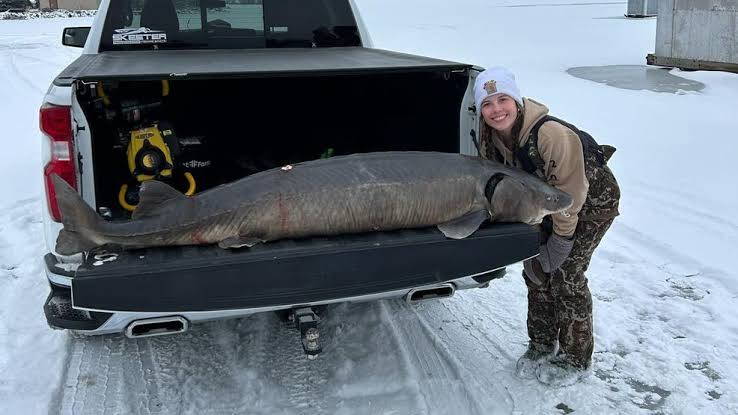Unbelievable: lake Winnebago sturgeon…
Lake Winnebago, located in central Wisconsin, is a vast body of water that stretches over 137 square miles. It is renowned for being one of the largest inland lakes in the United States and, most notably, for its annual sturgeon spearing season, which attracts thousands of people every winter. The sturgeon population in Lake Winnebago is among the most famous and unique in the world, with these ancient fish playing a key role in the ecosystem, history, and local culture of the region.
Sturgeon: Ancient Fish of the Lake
Sturgeon are some of the oldest and most primitive fish species, having existed for over 200 million years, even before the dinosaurs roamed the Earth. These fish are often referred to as “living fossils” because of their prehistoric characteristics. Sturgeon species are typically large, slow-growing, and long-lived, with some individuals in Lake Winnebago reaching up to 200 pounds and living for over 100 years.
The sturgeon in Lake Winnebago are a specific variety known as the Lake Sturgeon (Acipenser fulvescens). These fish have been an important part of the lake’s ecosystem for centuries. They are bottom feeders, primarily consuming a diet of invertebrates, such as worms, insect larvae, and crustaceans, which helps maintain a healthy balance in the lake’s environment. Sturgeon are also vital to the food chain, providing sustenance for larger predators like eagles, bears, and humans.
Historically, sturgeon were abundant in the Great Lakes region, but overfishing, habitat destruction, and pollution took a toll on their population. By the late 19th century, sturgeon numbers had plummeted, and the species was nearly extirpated from many areas. However, thanks to conservation efforts in the 20th century, sturgeon populations began to rebound, particularly in Lake Winnebago.
The Sturgeon Spearing Tradition
One of the most unique aspects of Lake Winnebago is its sturgeon spearing season, a tradition that dates back to the 1800s. The event is both a celebration and a challenge, as hunters brave the frigid winter temperatures in hopes of catching one of these majestic fish. The sturgeon spearing season typically runs from early February to mid-February and is closely regulated by the Wisconsin Department of Natural Resources (DNR) to ensure that the fish population remains sustainable.
During the season, participants use spears to catch sturgeon while standing on the frozen surface of the lake. They drill holes in the ice, sometimes measuring up to 6 feet in diameter, and then sit in small shanties or shelters over the hole, peering through the ice into the dark waters below. The goal is to spot the shadow of a sturgeon and, when the moment is right, strike with the spear.
The spearing season has grown in popularity over the years, with hundreds of licensed spearers participating annually. The DNR carefully monitors the number of sturgeon taken during the season to prevent overfishing, and there are strict rules governing the minimum size of sturgeon that can be harvested. Only mature fish, typically over 36 inches long, are allowed to be speared, ensuring that younger fish can continue to thrive in the lake and reproduce.
A Cultural and Community Event
The sturgeon spearing season is more than just a fishing competition; it is a significant cultural event for the communities surrounding Lake Winnebago. For many, it is a family tradition passed down through generations. Spearing for sturgeon is not just about the fish but also about community bonding, camaraderie, and a deep connection to the lake.
During the season, local businesses thrive as spectators and spearers gather in the area. Restaurants, taverns, and shops offer special sturgeon-themed dishes, and local festivals celebrate the event. The season is also an important time for educational programs, where locals and visitors can learn about the sturgeon’s history, biology, and conservation efforts. It is a time when both residents and tourists come together to honor the fish that has been a part of the lake’s heritage for centuries.
Conservation and Future of the Sturgeon
The future of the sturgeon population in Lake Winnebago is closely tied to conservation efforts. Over the years, the DNR has worked to protect and manage the sturgeon population through habitat restoration, water quality monitoring, and stocking programs. Hatcheries have been established to raise sturgeon and release them into the lake, ensuring a healthy and sustainable population for generations to come.
Despite these efforts, the challenges of preserving the sturgeon’s habitat remain. Pollution, invasive species, and climate change continue to threaten the delicate balance of the ecosystem. However, the strong connection between the sturgeon and the people of Lake Winnebago has sparked a collective effort to protect and preserve this ancient fish. By continuing conservation programs and maintaining the sturgeon spearing tradition in a sustainable way, there is hope that future generations will also have the opportunity to experience the thrill of spearing a sturgeon on Lake Winnebago.
In conclusion, the sturgeon of Lake Winnebago are not only an important part of the region’s ecology but also a symbol of the area’s rich history and culture. Their resilience, coupled with ongoing conservation efforts, ensures that this ancient fish will continue to thrive in the lake for years to come.



